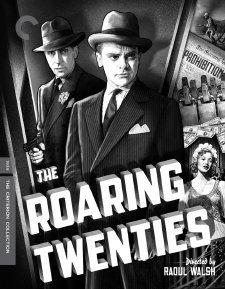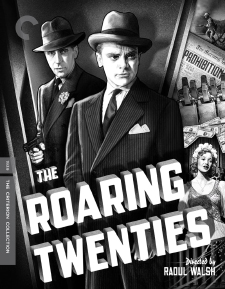Roaring Twenties, The (Blu-ray Review)

Director
Raoul WalshRelease Date(s)
1939 (February 27, 2024)Studio(s)
Warner Bros. (The Criterion Collection – Spine #1208)- Film/Program Grade: A
- Video Grade: A
- Audio Grade: A
- Extras Grade: A
Review
In a battleground foxhole during World War I, three American soldiers share temporary safety from enemy fire. These wartime strangers are destined to have their lives intertwine during post-war America’s Jazz Age. This extended prologue to Warner Brothers’ historical fiction The Roaring Twenties sets the stage for a two-decade story set in motion by the ill-considered effects of Prohibition.
Eddie Bartlett (James Cagney, Yankee Doodle Dandy), George Hally (Humphrey Bogart, The African Queen), and Lloyd Hart (Jeffrey Lynn, Million Dollar Baby) share their plans for resuming civilian life. Eddie wants to get his old job back at the garage he worked at before the war and to meet the young Long Island woman who wrote to him while he was in Europe. George doesn’t say much, but Lloyd talks about going back to school and becoming a lawyer.
Eddie finds his old job isn’t waiting for him and work in general is tough to obtain. The young woman, Jean Sherman (Priscilla Lane, Saboteur), turns out to be a school girl whose photo made her appear much older. Disappointed on both counts, he accepts the offer of his friend, taxi owner Danny Green (Frank McHugh, Going My Way), to drive his cab at night. This arrangement works out well for a time, but after Prohibition is enacted, Eddie innocently delivers a package for a fare and finds himself in jail for illegally transporting alcohol. Bailed out by speakeasy owner Panama Smith (Gladys George, The Maltese Falcon), he decides to make his living by providing what the public wants—booze.
Eddie asks his war buddy Lloyd, now a lawyer, for help. Lloyd knows Eddie’s pursuits are risky but joins him out of loyalty, and both do well financially. Lloyd knows how to make sure the right people are bribed to turn the other way.
In the meantime, Eddie encounters the schoolgirl he visited years ago, Jean Sherman, now a lovely, aspiring singer. Using his influence with speakeasy and nightclub owners, he makes sure she’s hired, and her career takes off. He looks to Jean as the perfect companion and turns the charm on full steam to impress her.
Things are going well for Eddie but become problematic when he runs into George, now also profiting from Prohibition as a rum runner. The two men ultimately agree to join forces when they realize that, together, they can rake in even greater cash. Unlike Eddie, however, George respects no boundaries and puts everyone in danger through an impetuous act.
From an original story by Mark Hellinger, The Roaring Twenties is bookmarked by major events—World War I, Prohibition, the Great Depression, and the repeal of Prohibition. The screenplay by Jerry Wald, Richard Macaulay and Robert Rossen moves briskly in typical Warner Brothers style with real-life events serving as backdrop for the film’s three main characters.
The Roaring Twenties was the last gangster film Cagney would make for the next ten years. In it, Cagney plays a softer version of the gangsters he played in the early 1930s. This time, he’s not a sociopath delighting in killing. He sees opportunity when traditional employment doors are closed to him and he buys up taxicabs as profits roll in, preparing for a legitimate career when Prohibition comes to an end. Cagney shows his trademark swagger and self-assurance but also the sadness and desperation of the down-and-out Eddie, so his acting chops get a nice workout. It doesn’t matter who’s on screen with him; your eyes are always fixed on Cagney.
Bogart’s character, George, has also enriched himself breaking the law but is cold-blooded and inherently cruel and deceptive. This was the last time Bogart would play the bad guy. He would appear in both The Maltese Falcon and Casablanca a few years later, establishing himself as a bona fide movie star. As George, we believe he’s a conscienceless thug through and through.
Priscilla Lane has a sweet personality and gets to sing several period songs. Her Jean finds herself caught in a quandary. She’s grateful to Eddie for getting her out of the chorus and into the solo spot but reluctant to be upfront with him about her true feelings.
Gladys Gorge has a great supporting role as Panama, the brash speakeasy proprietor/entertainer and Eddie’s confidante. Sashaying among the patrons, warbling a tune or encouraging them to drink up, she’s all glitz and glamour on the surface, but with a caring heart. She’s also an observer, and seems to know what characters are thinking before they act. Miss George knows how to communicate with her expressions which, in her case, are more effective than dialogue. She also has the film’s memorable curtain line.
Director Raoul Walsh presents an assortment of speakeasies, shootouts, betrayals, raids, music, and bootleg booze. Hellinger’s opening credits scroll states, “The characters are composites of people I knew, and the situations are those that actually occurred.” The newsreel-type montages and authoritative narration establish the time period and setting. Walsh is a master at directing scenes that seem spontaneous and authentic. He uses close-ups for the purpose they were intended—to show emotion or reactions—and he avoids padding. Every moment moves the narrative forward as he covers two decades in the changing social fabric of the country.
The Roaring Twenties was shot by director of photography Ernest Haller on 35 mm black & white film with spherical lenses and presented in the Academy aspect ratio of 1.37:1. According to information in the enclosed booklet, “the new digital master was created from the 35 mm nitrate original camera negative, in addition to a safety fine-grain for some sections, with both elements scanned and restored in 4K resolution.” This is a beautiful restoration with no visual imperfections. Clarity and contrast are superb, with deep, lush blacks and a very good grayscale. A scene at sea is fog shrouded, and the foxhole scene has bright flashes representing explosions close by. Production design captures the excitement of speakeasies with happy patrons, entertainment, and shady characters. Period automobiles and costumes reflect the era.
The soundtrack is English 1.0 LPCM. Optional English SDH subtitles are available. Dialogue is clear, with a distinctive Warner Brothers crispness. Cagney has a wise-guy quality to his voice when Eddie is with his cronies that gives way to soft gentleness when he’s with Jean. Sound effects include machine gun fire, rifle fire, pistol shots, homemade gin being swirled in a bathtub, cars screeching around corners, and ambient crowd noise in the speakeasies. John Deering provides deep-voiced narration to accompany brief montages of actual events. Several songs of the era, including My Melancholy Baby, Ain’t We Got Fun, I’m Just Wild About Harry, It Had to Be You, and A Shanty in Old Shanty Town, highlight the wild abandon and optimism of the Jazz Age.
Bonus materials on the Blu-ray release from The Criterion Collection include the following:
- Audio Commentary with Film Historian Lincoln Hurst
- New Interview with Gary Giddins (21:51)
- Excerpt from a 1973 interview with Raoul Walsh (4:34)
- Trailer (3:29)
Audio Commentary – The commentator regards The Roaring Twenties as one of 3 or 4 of the best gangster films ever made. Two great stars—Cagney and Bogart—were featured at the top of their game along with first-class behind-the-camera talent. The early montage is similar to the March of Time newsreels released at the time. Cagney and Bogart rise above the material. The three soldiers in the foxhole have their lives intertwined after the war. Cagney is Everyman, Bogart the bad guy, and Lynn the good guy. The film presents a sanitized version of the barbaric trench warfare of World War I. The Armistice marks a new life for all three men. The early scene between Cagney and Frank McHugh was worked out the night before it was shot because Cagney felt the script was lagging. Walsh encouraged the improvisation. Executive producer Hal Wallis worked under Jack Warner. Both Cagney and Walsh liked improvisational scenes, which drove Wallis crazy. Priscilla Lane was the youngest and prettiest of three sisters who appeared in movies and the only one to become a star. Cagney’s character, Eddie, is acted on by society. He’s not sinister but he lacks moral strength. He filters out information that doesn’t agree with his self-centered view. Cagney was exploring a man who was a victim of his own flaws. Raoul Walsh started as an actor and assistant director under D.W. Griffith, but an accident caused him to lose an eye and he turned to directing. Many scenes take place in speakeasies and saloons, a milieu that Walsh enjoyed. An early radio with headphones, circa 1925, is shown because Walsh was fascinated with technical equipment. The Hays Office was uneasy with the glorification of gangsters. Putting the story in the past and making the characters victims of society insulated the film from censorship. Director of photography Ernest Haller was known as a master of light and shadow. He worked with Bette Davis on Jezebel and Dark Victory. The crackling, crisp sound of the film is attributed to the old Western Electric sound system and the fact that Warner Brothers had superior technical expertise because the studio pioneered sound.
Interview with Film Critic Gary Giddens – The Roaring Twenties was a hit when originally released. In early gangster movies, such as Public Enemy, Little Caesar and Scarface, the lead character was a bad guy. With a more stringent Production Code, gangsters were depicted as less sociopathic. The prologue of The Roaring Twenties establishes the film as a historical drama. Its original title was The World Moves On. History is rewritten by Hollywood. Bootleggers were not thought of as hardened criminals. This is a gangster film without cops. Mark Hellinger was a famous New York columnist who wrote about seamy New York characters. Gladys George’s character was suggested by real-life Texas Guinan. The film, helped by period songs, “grabs you.” The film allows for various rhythms. Bogart would never play a secondary role after this film. After The Roaring Twenties, James Cagney didn’t make another gangster film until White Heat (1949). The Roaring Twenties isn’t regarded as highly as White Heat because it’s not as tough.
Excerpt from a 1973 Interview with Raoul Walsh – This except is from an episode of The Men Who Made the Movies directed by Richard Schickel, originally aired in 1973. Clips from The Roaring Twenties are shown, along with Walsh speaking about the star power of both Cagney and Bogart and their ability to involve audiences. He notes that you could kill a Cagney or Bogart character at the end of a movie but “You can never kill a Gable, a Cooper, a Peck.” Audiences wouldn’t stand for it. When asked why it took so long for Cagney to die, Walsh responded, “It’s always tough to kill an actor.”
Booklet – The enclosed accordion-style booklet contains the essay Into the Past by Mark Asch, a black & white still photo from the film, cast and crew listing, and information about the new digital master.
James Cagney and Humphrey Bogart starred in three films together, The Roaring Twenties being their last. The film takes the viewer from 1919 through the Jazz Age and closes right after the stock market crash ushers in the Great Depression. The period covered in the film saw vast changes in the lives and destinies of Americans. Many thrived when Prohibition made bootlegging profitable, and Cagney makes Eddie Brackett sympathetic because he’s essentially a good guy down on his luck. With a broad canvas, director Raoul Walsh highlights the era’s highs and lows while showcasing Cagney and Bogart at their peak.
- Dennis Seuling

